FSMSADF::Graph Class Reference
#include <graph.h>

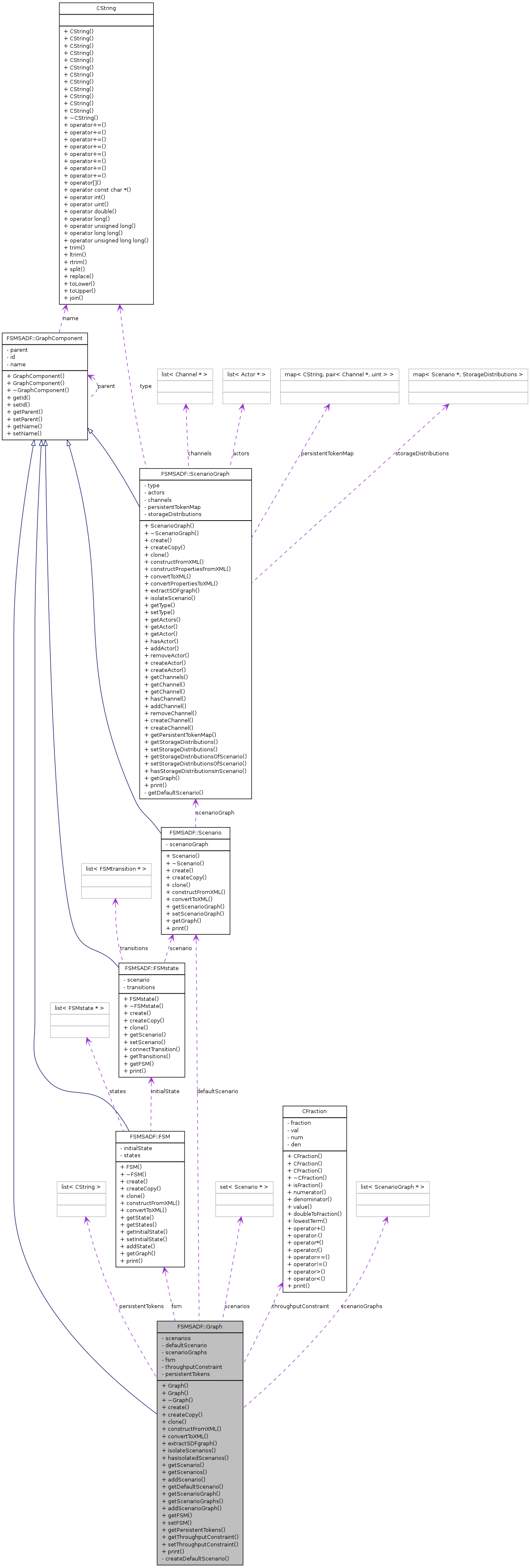
Detailed Description
Graph Container for FSM-based SADF graph.
Constructor & Destructor Documentation
| Graph::Graph | ( | GraphComponent | c | ) |
| Graph::Graph | ( | ) |
Graph () Constructor.
References createDefaultScenario().
Referenced by create().

| Graph::~Graph | ( | ) |
~Graph () Destructor.
References defaultScenario, fsm, and scenarioGraphs.
Member Function Documentation
| void FSMSADF::Graph::addScenario | ( | Scenario * | s | ) | [inline] |
References scenarios.
Referenced by clone(), constructFromXML(), and FSMSADF::RandomGraph::createScenario().
| void FSMSADF::Graph::addScenarioGraph | ( | ScenarioGraph * | g | ) | [inline] |
References scenarioGraphs.
Referenced by clone(), constructFromXML(), FSMSADF::RandomGraph::createScenarioGraph(), and isolateScenarios().
| Graph * Graph::clone | ( | GraphComponent | c | ) | const |
clone () The function returns a pointer to a newly allocated graph object. All properties, actors and channels of the graph are cloned.
References addScenario(), addScenarioGraph(), createCopy(), g, getDefaultScenario(), getFSM(), FSMSADF::GraphComponent::getId(), FSMSADF::GraphComponent::getName(), getScenario(), FSMSADF::Scenario::getScenarioGraph(), getScenarioGraph(), FSMSADF::GraphComponent::GraphComponent(), persistentTokens, scenarioGraphs, scenarios, and setFSM().
Referenced by FSMSADF::ToolAnalyze::analyzeGraph(), FSMSADF::RandomGraph::assignThroughputConstraint(), FSMSADF::BindingAwareGraph::constructBindingAwareGraph(), FSMSADF::GraphConversion::ensureStronglyBounded(), and FSMSADF::ToolTransform::transformGraph().
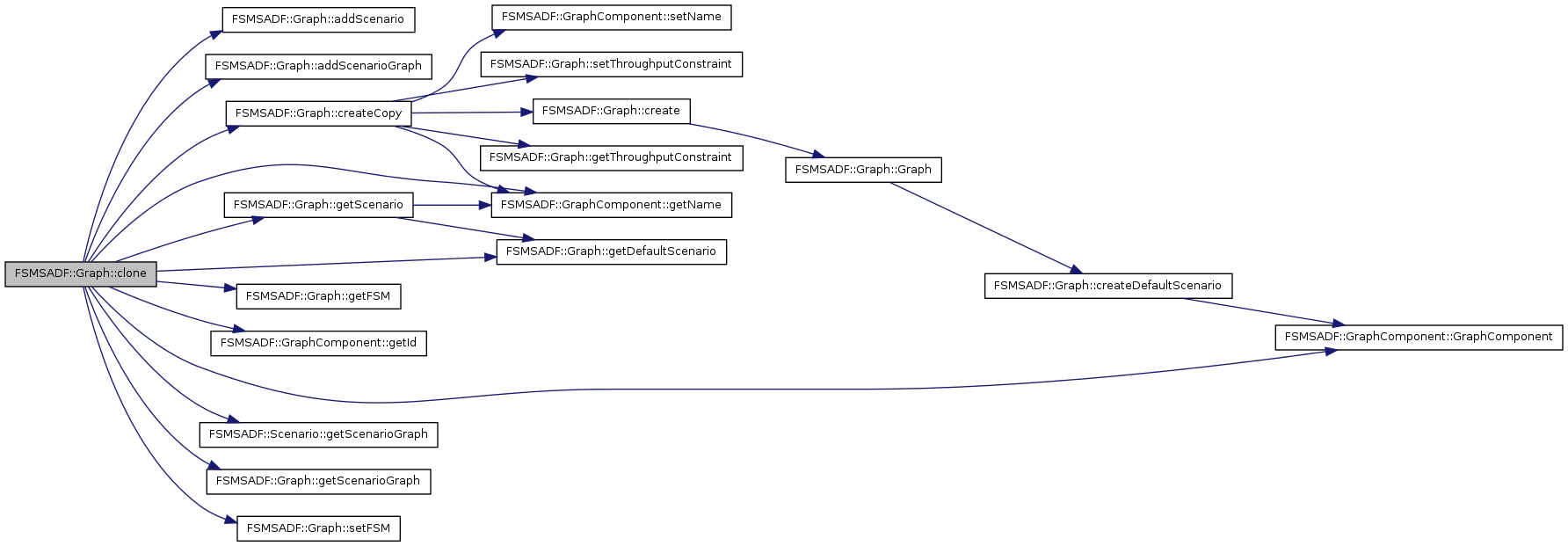
| void Graph::constructFromXML | ( | const CNodePtr | applicationGraphNode | ) |
constructFromXML () The function initializes all actor properties based on the XML data.
References addScenario(), addScenarioGraph(), CGetAttribute(), CGetChildNode(), CGetNodeContent(), CHasAttribute(), CHasChildNode(), CIsNode(), CNextNode(), FSMSADF::FSM::constructFromXML(), FSMSADF::ScenarioGraph::constructFromXML(), FSMSADF::ScenarioGraph::constructPropertiesFromXML(), fsm, getDefaultScenario(), getScenarioGraph(), getScenarioGraphs(), getScenarios(), FSMSADF::GraphComponent::GraphComponent(), FSMSADF::GraphComponent::name, persistentTokens, scenarioGraphs, FSMSADF::GraphComponent::setName(), FSMSADF::Scenario::setScenarioGraph(), setThroughputConstraint(), and throughputConstraint.
Referenced by FSMSADF::ToolAnalyze::analyzeGraph(), FSMSADF::SDF3Flow::constructFromXML(), FSMSADF::mapApplicationGraphToArchitectureGraph(), and FSMSADF::ToolTransform::transformGraph().
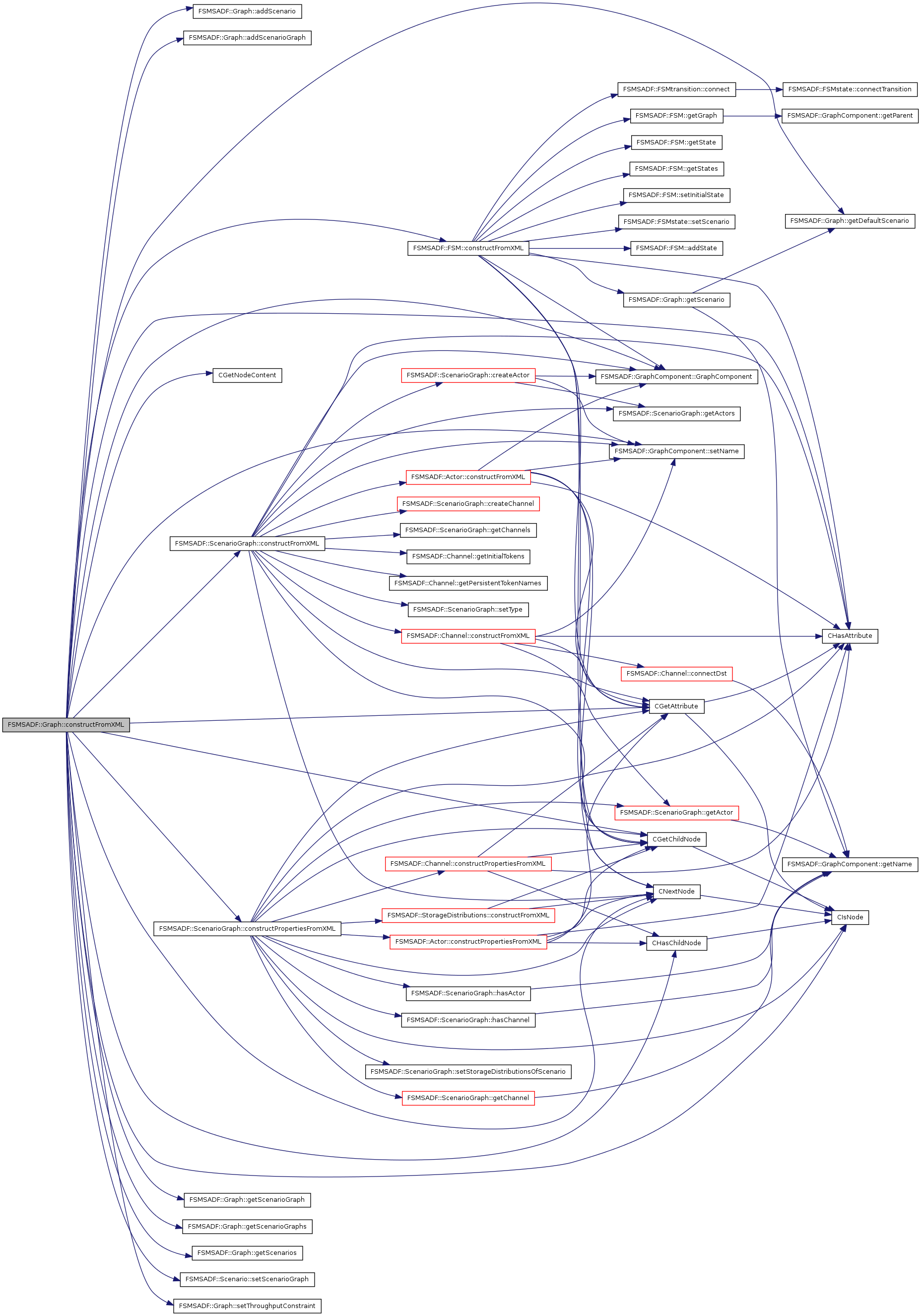
| void Graph::convertToXML | ( | const CNodePtr | applicationGraphNode | ) |
convertToXML () The function converts all the graph to XML data.
References CAddAttribute(), CAddNode(), FSMSADF::FSM::convertToXML(), FSMSADF::Scenario::convertToXML(), FSMSADF::ScenarioGraph::convertToXML(), fsm, FSMSADF::ScenarioGraph::getActors(), FSMSADF::ScenarioGraph::getChannels(), getDefaultScenario(), FSMSADF::GraphComponent::getName(), FSMSADF::Scenario::getScenarioGraph(), getThroughputConstraint(), scenarioGraphs, and scenarios.
Referenced by FSMSADF::ToolAnalyze::analyzeGraph(), FSMSADF::SDF3Flow::convertToXML(), FSMSADF::ToolGenerate::generateRandomGraph(), and FSMSADF::ToolTransform::transformGraph().
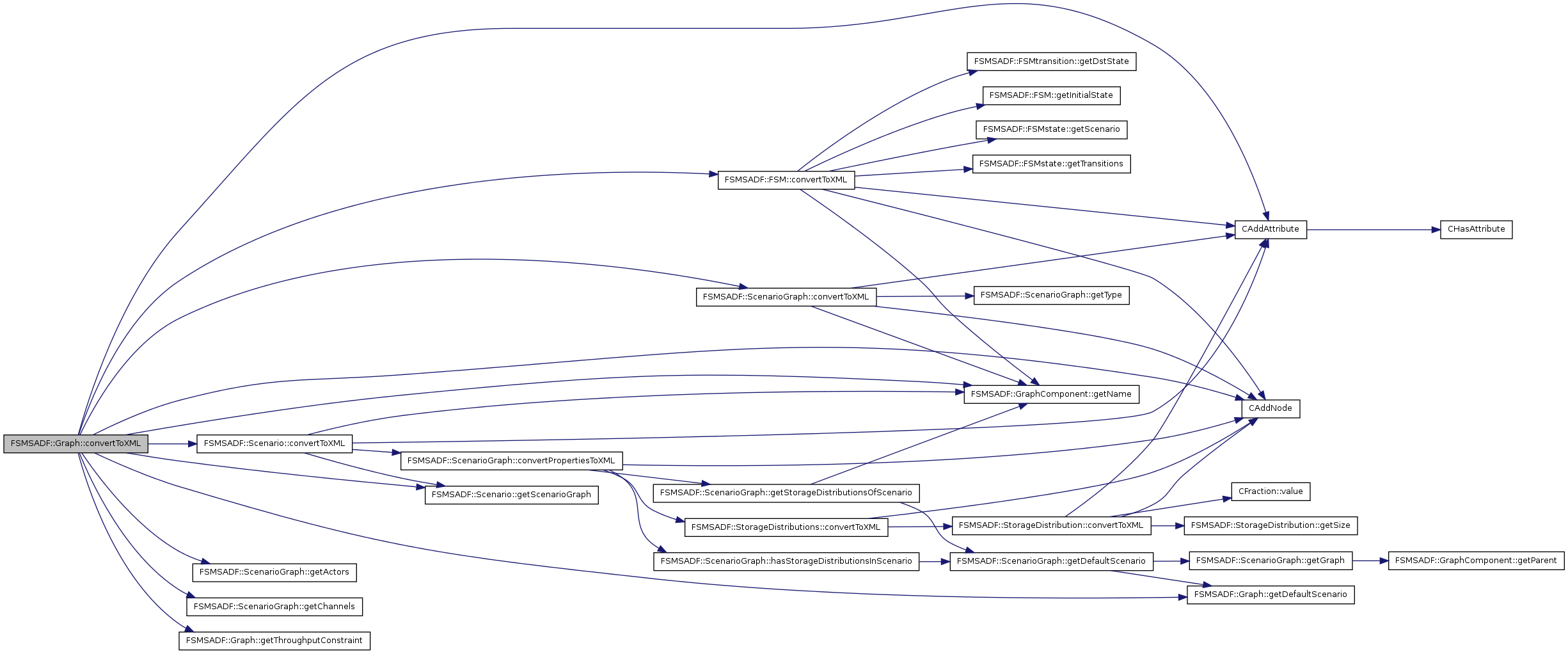
| Graph * Graph::create | ( | GraphComponent | c | ) | const |
create () The function returns a pointer to a newly allocated graph object.
References Graph().
Referenced by createCopy().

| Graph * Graph::createCopy | ( | GraphComponent | c | ) | const |
createCopy () The function returns a pointer to a newly allocated graph object. All properties of the graph are copied.
References create(), g, FSMSADF::GraphComponent::getName(), getThroughputConstraint(), FSMSADF::GraphComponent::setName(), and setThroughputConstraint().
Referenced by clone().

| void Graph::createDefaultScenario | ( | ) | [private] |
createDefaultScenario() Create a default scenario. This scenario is not part of the set of scenarios. It is just used as a NULL object to store default properties.
References component, defaultScenario, and FSMSADF::GraphComponent::GraphComponent().
Referenced by Graph().

| TimedSDFgraph * Graph::extractSDFgraph | ( | Scenario * | s | ) | const |
extractSDFgraph() The function converts the scenario graph of scenario s to a timed SDF graph.
References FSMSADF::ScenarioGraph::extractSDFgraph(), and FSMSADF::Scenario::getScenarioGraph().
Referenced by FSMSADF::ToolAnalyze::analyzeGraph(), FSMSADF::GraphConversion::computeMaxPlusMatricesFromScenarios(), and FSMSADF::ToolTransform::transformGraph().
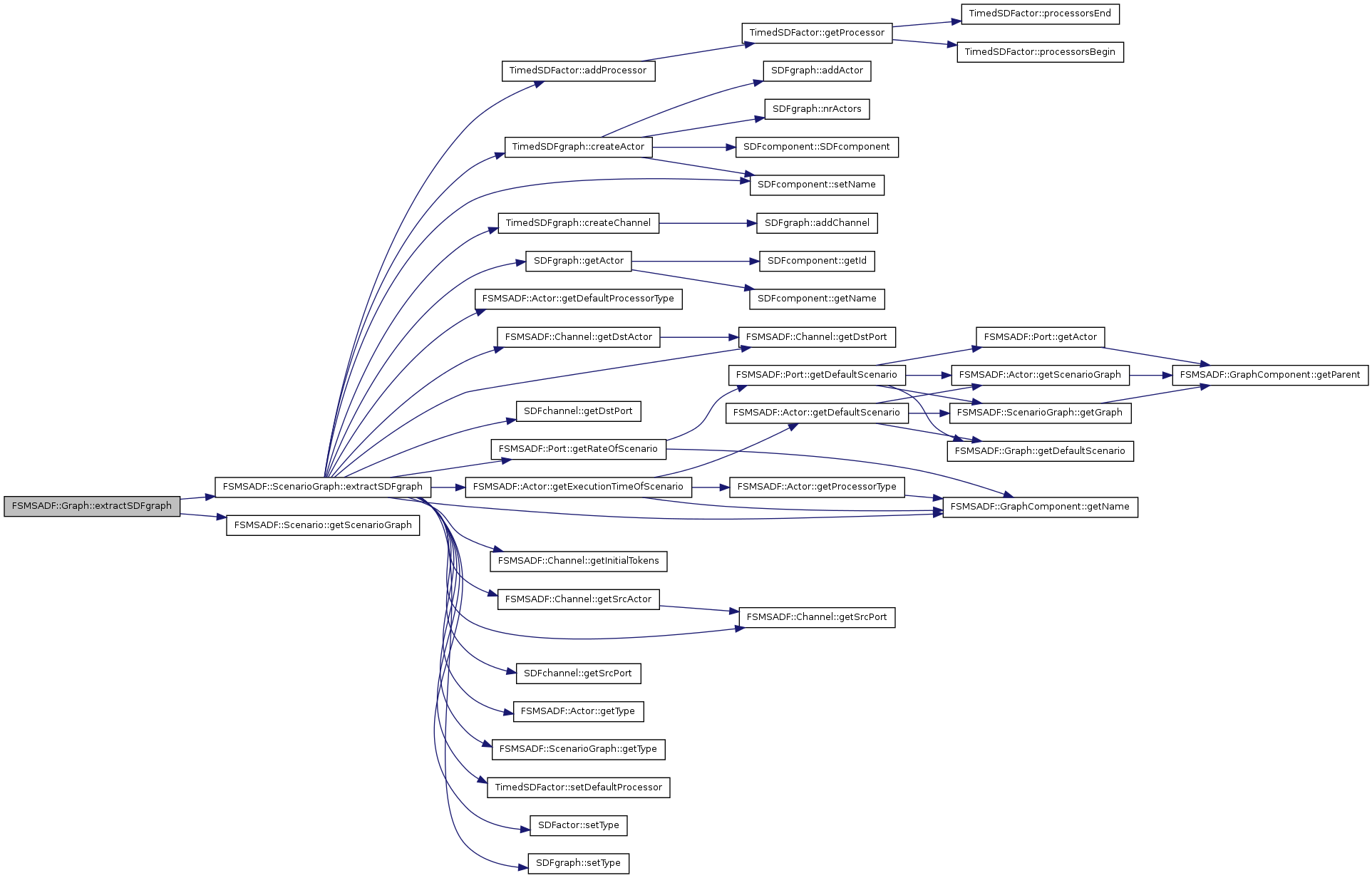
| Scenario * Graph::getDefaultScenario | ( | ) | const |
getDefaultScenario() The function returns a pointer to the default scenario.
References defaultScenario.
Referenced by clone(), constructFromXML(), convertToXML(), FSMSADF::GraphConversion::ensureStronglyBounded(), FSMSADF::Port::getDefaultScenario(), FSMSADF::ScenarioGraph::getDefaultScenario(), FSMSADF::Channel::getDefaultScenario(), FSMSADF::Actor::getDefaultScenario(), and getScenario().
| FSM* FSMSADF::Graph::getFSM | ( | ) | const [inline] |
References fsm.
Referenced by FSMSADF::MPExploreMaxPlusAutomaton::ThroughputCalculator::calculateThroughput(), clone(), FSMSADF::MPExploreStateSpace::StateSpaceExploration::exploreThroughput(), FSMSADF::MPExploreStateSpace::StateSpaceExploration::exploreThroughputMax(), and FSMSADF::OutputHTML::printApplicationGraph().
| const CStrings FSMSADF::Graph::getPersistentTokens | ( | ) | const [inline] |
References persistentTokens.
Referenced by FSMSADF::GraphConversion::computeMaxPlusMatricesFromScenarios().
getScenario() The function returns a pointer to the scenario with the supplied name.
References getDefaultScenario(), FSMSADF::GraphComponent::getName(), and scenarios.
Referenced by clone(), FSMSADF::FSMstate::clone(), FSMSADF::GraphBindingConstraints::clone(), FSMSADF::PlatformBinding::constructFromXML(), FSMSADF::FSM::constructFromXML(), FSMSADF::BindingAwareGraph::extractActorMapping(), FSMSADF::BindingAwareGraph::extractChannelMapping(), FSMSADF::EarliestDeadLineFirstScheduling::scheduleScenario(), FSMSADF::Actor::setProcessorTypes(), FSMSADF::Port::setRate(), FSMSADF::Channel::setTokenSize(), and FSMSADF::ToolTransform::transformGraph().

| ScenarioGraph * Graph::getScenarioGraph | ( | const CString & | name | ) | const |
getScenarioGraph() The function returns a pointer to the scenario graph with the supplied name.
References scenarioGraphs.
Referenced by FSMSADF::Scenario::clone(), clone(), FSMSADF::Scenario::constructFromXML(), and constructFromXML().
| ScenarioGraphs& FSMSADF::Graph::getScenarioGraphs | ( | ) | [inline] |
References scenarioGraphs.
Referenced by FSMSADF::RandomGraph::assignProperties(), FSMSADF::RandomGraph::assignRatesAndInitialTokens(), constructFromXML(), FSMSADF::RandomGraph::createGraph(), FSMSADF::RandomGraph::createScenario(), FSMSADF::RandomGraph::createScenarioGraph(), FSMSADF::GraphConversion::ensureStronglyBounded(), FSMSADF::mapApplicationGraphToArchitectureGraph(), and FSMSADF::BindingAwareGraph::modelBindingInNSoCFlow().
| Scenarios& FSMSADF::Graph::getScenarios | ( | ) | [inline] |
References scenarios.
Referenced by FSMSADF::ToolAnalyze::analyzeGraph(), FSMSADF::RandomGraph::assignProperties(), FSMSADF::RandomGraph::assignRatesAndInitialTokens(), FSMSADF::GraphConversion::computeMaxPlusMatricesFromScenarios(), FSMSADF::MemoryDimAlgo::computeStorageDist(), constructFromXML(), FSMSADF::PlatformBinding::convertToXML(), FSMSADF::RandomGraph::createFSM(), FSMSADF::RandomGraph::createGraph(), FSMSADF::RandomGraph::createScenario(), FSMSADF::MemoryDimAlgo::estimateStorageDist(), FSMSADF::findAllScenariosOfActor(), FSMSADF::NetworkInterfaceBinding::getInBandwidthUsedForGraph(), FSMSADF::MemoryBinding::getMemorySizeUsedForGraph(), FSMSADF::NetworkInterfaceBinding::getNrInConnectionsUsedForGraph(), FSMSADF::NetworkInterfaceBinding::getNrOutConnectionsUsedForGraph(), FSMSADF::NetworkInterfaceBinding::getOutBandwidthUsedForGraph(), FSMSADF::BindingAwareGraph::getScenarioOfScenarioGraph(), FSMSADF::ProcessorBinding::getWheelsizeUsedForGraph(), FSMSADF::OutputHTML::printApplicationGraph(), FSMSADF::OutputHTML::printPlatformBinding(), FSMSADF::OutputHTML::printPlatformBindings(), and FSMSADF::EarliestDeadLineFirstScheduling::schedule().
| Throughput FSMSADF::Graph::getThroughputConstraint | ( | ) | const [inline] |
References throughputConstraint.
Referenced by convertToXML(), and createCopy().
| bool Graph::hasIsolatedScenarios | ( | ) | const |
hasIsolatedScenarios() The function returns true when the scenarios in the graph are isolated (i.e. each scenario graph is used in exactly one scenario). Otherwise the function returns false.
References FSMSADF::Scenario::getScenarioGraph(), and scenarios.
Referenced by FSMSADF::MemoryDimAlgo::computeStorageDist(), FSMSADF::BindingAwareGraph::constructBindingAwareGraph(), and FSMSADF::MemoryDimAlgo::init().

| void Graph::isolateScenarios | ( | ) |
isolateScenarios() The function creates a seperate scenario graph for each scenario.
References addScenarioGraph(), FSMSADF::ScenarioGraph::clone(), FSMSADF::GraphComponent::getId(), FSMSADF::GraphComponent::getName(), FSMSADF::Scenario::getScenarioGraph(), FSMSADF::ScenarioGraph::isolateScenario(), scenarioGraphs, scenarios, FSMSADF::GraphComponent::setId(), FSMSADF::GraphComponent::setName(), and FSMSADF::Scenario::setScenarioGraph().
Referenced by FSMSADF::ToolAnalyze::analyzeGraph(), and FSMSADF::SDF3Flow::checkInputDesignFlow().
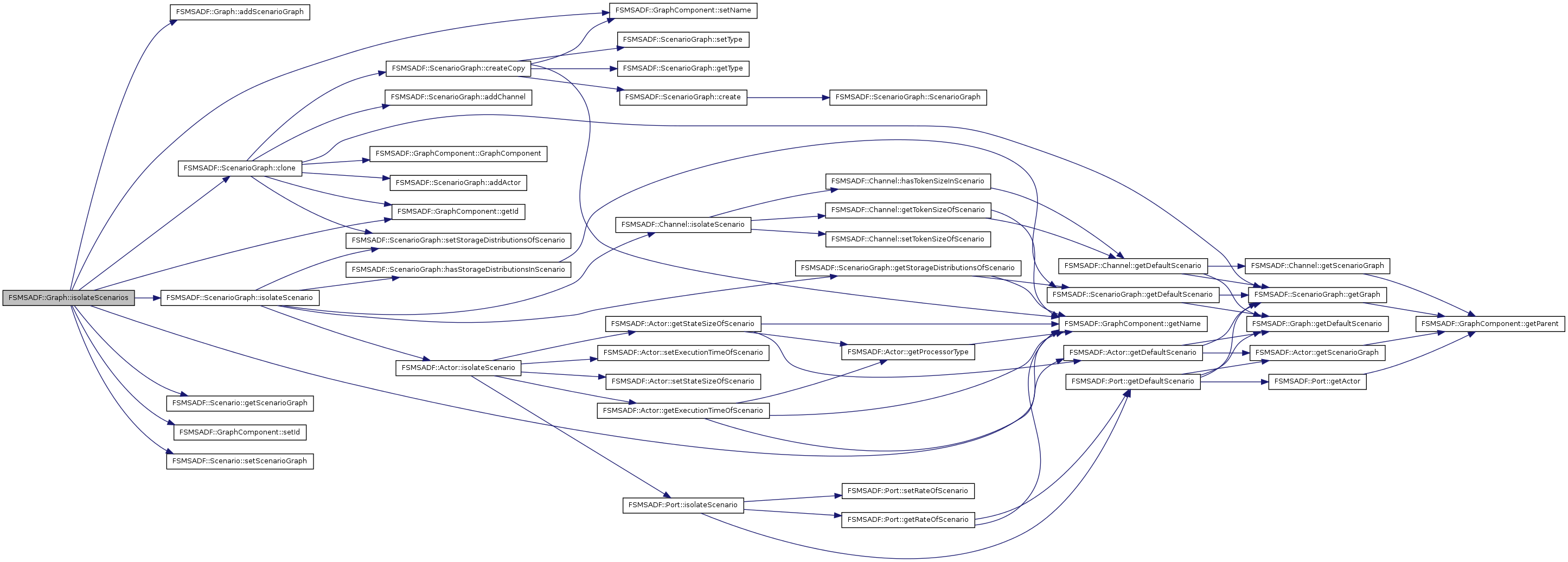
| ostream & Graph::print | ( | ostream & | out | ) |
print () Print the graph to the supplied output stream.
References fsm, FSMSADF::GraphComponent::getId(), FSMSADF::GraphComponent::getName(), FSMSADF::FSM::print(), scenarioGraphs, and scenarios.
Referenced by FSMSADF::ToolAnalyze::analyzeGraph().

| void FSMSADF::Graph::setFSM | ( | FSM * | f | ) | [inline] |
References fsm.
Referenced by clone(), and FSMSADF::RandomGraph::createFSM().
| void FSMSADF::Graph::setThroughputConstraint | ( | const Throughput & | t | ) | [inline] |
References throughputConstraint.
Referenced by constructFromXML(), and createCopy().
Friends And Related Function Documentation
| ostream& operator<< | ( | ostream & | out, | |
| Graph & | g | |||
| ) | [friend] |
Member Data Documentation
Scenario* FSMSADF::Graph::defaultScenario [private] |
Referenced by createDefaultScenario(), getDefaultScenario(), and ~Graph().
FSM* FSMSADF::Graph::fsm [private] |
Referenced by constructFromXML(), convertToXML(), getFSM(), print(), setFSM(), and ~Graph().
CStrings FSMSADF::Graph::persistentTokens [private] |
Referenced by clone(), constructFromXML(), and getPersistentTokens().
ScenarioGraphs FSMSADF::Graph::scenarioGraphs [private] |
Referenced by addScenarioGraph(), clone(), constructFromXML(), convertToXML(), getScenarioGraph(), getScenarioGraphs(), isolateScenarios(), print(), and ~Graph().
Scenarios FSMSADF::Graph::scenarios [private] |
Referenced by addScenario(), clone(), convertToXML(), getScenario(), getScenarios(), hasIsolatedScenarios(), isolateScenarios(), and print().
Referenced by constructFromXML(), getThroughputConstraint(), and setThroughputConstraint().
The documentation for this class was generated from the following files:


